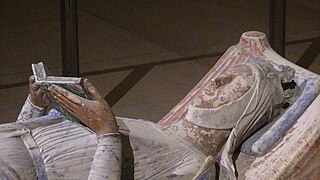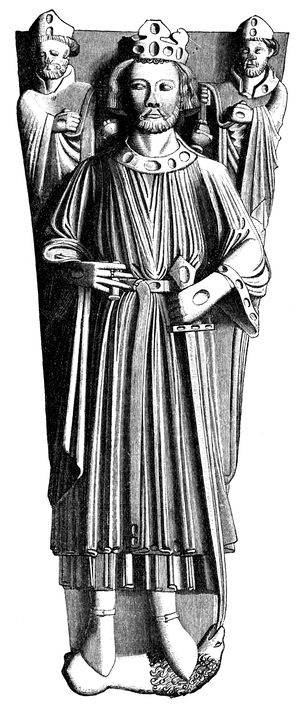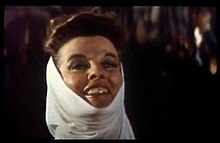
Eleanor of Aquitaine was Duchess of Aquitaine in her own right from 1137 to 1204, Queen of France from 1137 to 1152 as the wife of King Louis VII, and Queen of England from 1154 to 1189 as the wife of King Henry II. As the heiress of the House of Poitiers, which controlled much of southwestern France, she was one of the wealthiest and most powerful women in Western Europe during the High Middle Ages. Militarily, she was a leading figure in the Second Crusade, and in a revolt in favour of her son. Culturally, she was a patron of poets such as Wace, Benoît de Sainte-Maure, and Bernart de Ventadorn, and of the arts of the High Middle Ages.

John was the king of England from 1199 until his death in 1216. He lost the Duchy of Normandy and most of his other French lands to King Philip II of France, resulting in the collapse of the Angevin Empire and contributing to the subsequent growth in power of the French Capetian dynasty during the 13th century. The baronial revolt at the end of John's reign led to the sealing of Magna Carta, a document considered an early step in the evolution of the constitution of the United Kingdom.

Richard I, known as Richard Cœur de Lion or Richard the Lionheart because of his reputation as a great military leader and warrior, was King of England from 1189 until his death in 1199. He also ruled as Duke of Normandy, Aquitaine, and Gascony; Lord of Cyprus; Count of Poitiers, Anjou, Maine, and Nantes; and was overlord of Brittany at various times during the same period. He was the third of five sons of Henry II of England and Eleanor of Aquitaine and was therefore not expected to become king, but his two elder brothers predeceased their father.

Louis VII, called the Younger, or the Young, was King of France from 1137 to 1180. He was the son and successor of King Louis VI and married Duchess Eleanor of Aquitaine, one of the wealthiest and most powerful women in western Europe. The marriage temporarily extended the Capetian lands to the Pyrenees.
The Lion in Winter is a 1966 play by James Goldman, depicting the personal and political conflicts of Henry II of England, his wife Eleanor of Aquitaine, their children and their guests during Christmas 1183. It premiered on Broadway at the Ambassador Theatre on March 3, 1966, starring Robert Preston and Rosemary Harris, who won a Tony Award for her portrayal of Eleanor. It was adapted by Goldman into an Academy Award-winning 1968 film of the same name, starring Peter O'Toole and Katharine Hepburn. The play has been produced numerous times, including Broadway and West End revivals.

Rosamund Clifford, often called "The Fair Rosamund" or "Rose of the World", was a medieval English noblewoman and mistress of Henry II, King of England, and she became famous in English folklore.

Geoffrey II was Duke of Brittany and 3rd Earl of Richmond between 1181 and 1186, through his marriage to Constance, Duchess of Brittany. Geoffrey was the fourth of five sons of Henry II of England and Eleanor, Duchess of Aquitaine.

The term Angevin Empire describes the possessions held by the House of Plantagenet during the 12th and 13th centuries, when they ruled over an area covering roughly all of present-day England, half of France, and parts of Ireland and Wales, and had further influence over much of the remaining British Isles. It may be described as an early example of a composite monarchy. The empire was established by Henry II of England, who succeeded his father Geoffrey as Duke of Normandy and Count of Anjou. Henry married Eleanor of Aquitaine in 1152, acquiring the Duchy of Aquitaine, and inherited his mother Empress Matilda's claim to the English throne, succeeding his rival Stephen in 1154. Although their title of highest rank came from the Kingdom of England, the Plantagenets held court primarily on the continent at Angers in Anjou, and at Chinon in Touraine.
Alys of France, Countess of Vexin, known in English as "Alice", was a French princess, initially betrothed to Richard I of England. Her engagement was broken in 1190, through negotiations between Richard and her half-brother Philip Augustus of France. Philip then attempted to betroth her to King John of England but it was rejected. Alys married William IV, Count of Ponthieu on 20 August 1195. She died between 1218 and 1220.

Becket is a 1964 British historical drama film about the historic, tumultuous relationship between Henry II of England and his friend-turned-bishop Thomas Becket. It is a dramatic film adaptation of the 1959 play Becket or the Honour of God by Jean Anouilh made by Hal Wallis Productions and released by Paramount Pictures. It was directed by Peter Glenville and produced by Hal B. Wallis with Joseph H. Hazen as executive producer. The screenplay was written by Edward Anhalt based on Anouilh's play. The music score was by Laurence Rosenthal, the cinematography by Geoffrey Unsworth and the editing by Anne V. Coates.

The Lion in Winter is a 2003 American drama television film based on the 1966 play of the same name by James Goldman, and his screenplay for the 1968 film. It starred Patrick Stewart and Glenn Close, and was directed by Andrei Konchalovsky.
Anthony Harvey was an English filmmaker who began his career as a teenage actor, was a film editor in the 1950s and moved into directing in the mid-1960s. Harvey had fifteen film credits as an editor, and he directed thirteen films. The second film that Harvey directed, The Lion in Winter (1968), earned him a nomination for the Academy Award for Best Director. Harvey's career is also notable for his recurring work with a number of leading actors and directors including Terry-Thomas, Peter Sellers, Katharine Hepburn, Peter O'Toole, Richard Attenborough, Liv Ullman, Sam Waterston, Nick Nolte, the Boulting Brothers, Anthony Asquith, Bryan Forbes and Stanley Kubrick. He died in November 2017 at the age of 87.
Events from the 1180s in England.
Geoffrey VI was Count of Nantes from 1156 to 1158. He was also known as Geoffrey of Anjou and Geoffrey FitzEmpress. He was the son of Geoffrey Plantagenet and Empress Matilda. His brothers were Henry II of England and William FitzEmpress.
Events from the 1150s in England.
Henry II ruled as King of England from 1154 to 1189 and at various times he also partially controlled Scotland, Wales, Ireland and the Duchy of Brittany. He has been depicted in various cultural media.
The Devil's Crown is a BBC television series which dramatised the reigns of three medieval Kings of England: Henry II and his sons Richard I and John. It is also known as La couronne du Diable in French.

Château de Chinon is a château located on the bank of the river Vienne in Chinon, France. It was founded by Theobald I, Count of Blois. In the 11th century the castle became the property of the counts of Anjou. In 1156 Henry II of England, a member of the House of Anjou, took the castle from his brother Geoffrey, Count of Nantes, after Geoffrey rebelled for a second time. Henry favoured the Château de Chinon as a residence. Most of the standing structure can be attributed to his reign; he died there in 1189.
Martin Poll was an American film and television producer. Poll produced eleven feature films during his career, including The Lion in Winter, for which he received a 1968 Academy Award nomination for Academy Award for Best Picture. The Lion in Winter, which starred Katharine Hepburn and Peter O'Toole, received nine nominations and won three Academy Awards. It also won a Golden Globe Award for Best Motion Picture – Drama.

The Angevin kings of England were Henry II and his sons, Richard I and John, who ruled England from 1154 to 1216. With ancestral lands in Anjou, they were related to the Norman kings of England through Matilda, the daughter of Henry I, and Henry II's mother. They were also related to the earlier Anglo-Saxon kings of England through Matilda's great-great-great grandfather, Aethelred the Unready. Their descendants, the main line of Plantagenets, continued to rule England until 1485; some historians make no distinction between the Angevins and the Plantagenets, while others name John's son Henry III the first Plantagenet king.













